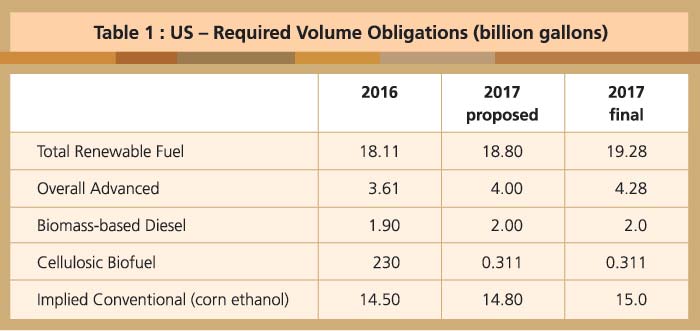Game-Changer in US Biofuels Sector
By gofb-adm on Wednesday, June 21st, 2017 in Biofuels, Issue 2 - 2017 No Comments

By gofb-adm on Wednesday, June 21st, 2017 in Biofuels, Issue 2 - 2017 No Comments
At the insistence of US President Donald Trump, climate change was not on the agenda when he met with Chinese Premier Xi Jinping in early April. This came after Trump signed an executive order on March 28, directing the EPA to roll back the Obama-era Clean Air Action Plan that called for a 26% reduction in US greenhouse gas (GHG) emissions from electric utilities by 2025.
Read more »By gofb-adm on Wednesday, June 21st, 2017 in Biofuels, Issue 2 - 2017 No Comments
The US National Biodiesel Board (NBB), which is an industry association, has filed an anti-dumping and countervailing petition with the US Department of Commerce and US International Trade Commission, against Argentine and Indonesian biodiesel imports.
Read more »By gofb-adm on Saturday, February 18th, 2017 in Biofuels, Issue 1 - 2017 No Comments
On Nov 23, 2016, the US Environmental Protection Agency (EPA) finalised the 2017 Required Volume Obligations (RVOs) for biofuels under the Renewable Fuel Standard (RFS). The overall volume was increased to 19.28 billion gallons versus the 18.8 billion gallons proposed by the agency on May 18.
This was the fourth consecutive year the EPA has boosted final volumes from the initial proposal and only the third time they have been finalised by the Nov 30 statutory deadline. The announcement was welcome news for the renewable fuels sector and will mean growth in both ethanol and biodiesel production, as well as consumption, in 2017.
Why WPI is bullish
• Increased RFS volumes will boost demand for biodiesel and ethanol
• Higher RINs prices will support blending of ethanol and biodiesel
• Exports will help add value to ethanol producers
• Fulfilling the advanced biofuels mandate will require more biodiesel
• Loss of the biodiesel blenders’ credit will lower biodiesel profitability
The 428 million gallon boost in the renewable fuel volume (Table 1) was based on the increases of 200 million gallons for the implied conventional biofuel (i.e. corn ethanol) category and 228 million gallons for the advanced category.

Source: EPA, WPI
Biodiesel producers generally maintained profitable margins last year and will see slightly higher supply and demand in 2017 as a result of the RVOs (Figure 1).

Source: USDA, EIA, WPI
While the 2017 and 2018 RVOs for biodiesel remained the same as the proposed rule, the increase in the overall advanced category will likely rely on that particular fuel to meet the target. This is because there is neither enough cellulosic nor other advanced biofuels supply to meet the overall volume requirements. Indeed, on the day of the EPA’s announcement, the January soybean oil futures contract rose from $0.34 to $0.37 based on the assumption that more biodiesel production would draw down end-of-the-year stocks.
By GOFB on Saturday, March 26th, 2016 in Biofuels, Issue 1 - 2016 No Comments
Indonesia’s B15 biodiesel programme stipulates to blend a mandatory 15% of fatty acid methyl ester (FAME, derived from palm oil) with 85% of diesel.
Read more »